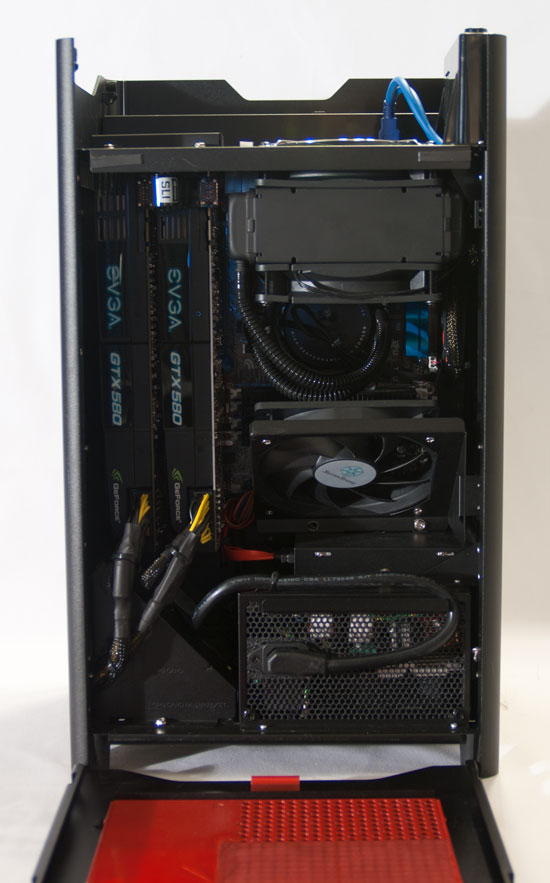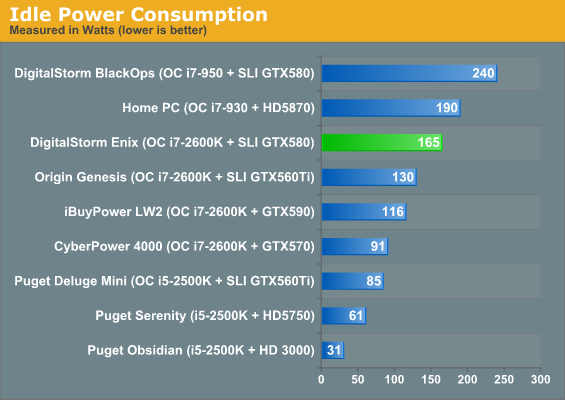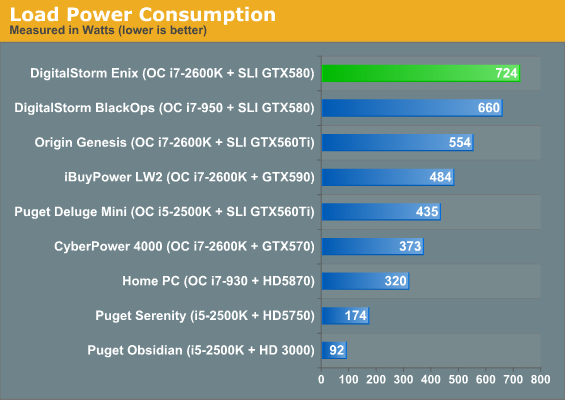DigitalStorm Enix: Phenomenal Cosmic Power, Itty Bitty Living Space
by Dustin Sklavos on May 12, 2011 12:00 AM EST- Posted in
- Systems
- Intel
- Sandy Bridge
- SilverStone
- DigitalStorm
Build, Noise, Heat, and Power Consumption
Given the SilverStone FT03's essentially compact frame but excellent thermal qualities (particularly for blower-style graphics hardware), it would be easy to pin a lot of the DigitalStorm Enix's success on SilverStone's engineering. But as we've seen with the different boutiques, which chassis to use for which build is still a choice specific to that boutique, and DigitalStorm's choice to use SilverStone Fortress series enclosures for both of their review units speaks highly of them. This is an important decision and we're pleased to see no corners were cut.
That said, our experience with SilverStone's enclosures is that their stock configurations seem almost designed expressly for fine-tuning by the end user. While the red trim added to the plastic grilles of the FT03 is a nice touch, it doesn't take away from the fact that DigitalStorm could've done a bit more with this enclosure. They offer fine-tuning and even replacement of the fans in the FT03, and that would've been appreciated in our review unit as the stock fans in the FT03 can be a bit noisy--effective, yes, but still noisy. This case can do better and should in the hands of a custom builder.

As you can see, the inside of the FT03 is pretty packed due in no small part to the massive pair of graphics cards and the equally substantial Corsair H70 water-cooling rig. The H70 proves to be remarkably effective at dissipating heat in this enclosure, but I found something troubling when I monitored heat and voltage. Check out these thermals:

The high temperatures on the GTX 580s are still well within spec for those cards, but look at the core temperatures on the i7-2600K and then take a look at the Vcore. We've noticed in testing that when the system boots up, there's a large spike in the Vcore up to 1.52-1.54V, which is disturbingly high. This spike does level off after about a minute, and in stress testing with Prime95 the voltage peaks at a less troubling 1.48V.
Of course, that's still incredibly high for a 32nm processor, and high enough to give me pause about the processor's continued stability and lifespan at this overclock and voltage. DigitalStorm's engineers did say this was about right for how they ship the processor and their warranty will cover it if it goes south, but that doesn't change the fact that this voltage seems far too high.
I had a reader email me and suggest that if I'm going to cite lazy overclocks in boutique systems, I should try overclocking the chips myself. I agree by half: I'm not going to try to push the chips any harder (especially since these vendors do make some money in charging for higher overclocks), but I can definitely see if I can get the voltage to run lower. A quick and dirty visit into the ASUS board's UEFI showed a +0.21V offset on the processor; I was able to reduce this to +0.06V and still achieve stability in a quick five-iteration Standard run of IntelBurnTest. This isn't a rock solid stability test, but I was able to increment down far enough that conceivably within the 0.15V range I tested in there's a 24/7 stable setting. I'm still certain I probably could've gone lower on the offset, but my point is essentially made: this could've been tuned a lot better. Just my reduction in voltage brought load temperatures down 10C on the processor cores.


And the high voltage on the i7-2600K takes its pound of flesh. At stock speeds the i7 and pair of GTX 580s have a combined TDP of 583 watts. When load tested in Mafia II (which hammers both the processor and graphics subsystems surprisingly hard), the Enix consumes a staggering 724 watts. Raising the Vcore as much as DigitalStorm did can dramatically increase power consumption, and that seems to be exactly what's happening here. Even the i7-950 in their BlackOps wasn't overvolted this far (though it also isn't nearly this fast).
















32 Comments
View All Comments
xxtypersxx - Friday, May 13, 2011 - link
Actually I just checked Asus's website again and they just released a newer 0709 bios last week. That should bring the stable LLC with an official BIOS.I'm really glad they finally sorted this out, the P8P67M-Pro is currently the only real viable option for a mATX overclocking board that supports sli and it has been frustrating to have it hampered with flaky bios versions. If you find the same results with voltage stability that I did then this should go a long way towards improving the power draw, noise, and thermals of this little powerhouse.
DigitalStorm - Tuesday, May 17, 2011 - link
Perfect.